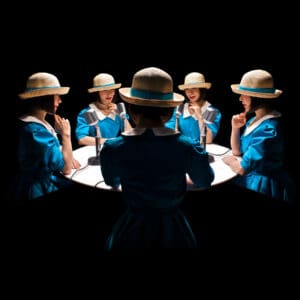She’s Not There: ZERO HOUR: TOKYO ROSE’S LAST TAPE Alights at Towson
Posted on BroadwayWorld.com February 16, 2015
Zero Hour: Tokyo Rose’s Last Tape, a full-length theater piece created by artist Miwa Yanagi, now touring after a brief stand at the Asia Society in New York, and at the Kennedy Center in Washington, alit at Stephens Hall at Towson University on Friday night. It is well known that “Tokyo Rose,” the monicker given to a collective of young women who broadcast music and commentary on the NHK network aimed at American military men in the Pacific during World War Two, was never a single person. The single identity covering multiple women is Yanagi’s starting point, and she does various things with it.
First, though, what she does not do: tell the story straight. She adapts the names of the characters (Iva Ikuko Toguri d’Aquino becomes Annie Yukuko Oguri Moreno), or changes them completely (two European American reporters named Brundidge and Lee become a single Asian American named Daniel Yamada). She reduces the number of participants in the Tokyo Rose collective. She gives another male character a role in the Toguri/Oguri trial when he was in real life barred from testifying, and so on. This is not journalism; this is not even fictionalization like Inherit the Wind. As an experience it is more akin to the endless, mysterious film loops one can sometimes see at the Museum of Modern Art.
Yanagi’s central conceit is that the “real” Tokyo Rose, the one the xenophobic revenge-seekers in America wanted to put on trial for more treasonous comments than were voiced by the others, was someone other than Toguri/Oguri – and indeed someone different from anyone identified as having been part of the collective. As we hear the voice of the “real” Tokyo Rose, it does seems that her sometimes guttural, sometimes screechy, sometimes seductive tone emanates from the Japanese national spirit and no mere individual. Yanagi is almost certainly right that the authorities convicted the wrong Tokyo Rose, but the main point isn’t that, but rather that the spirit of Tokyo Rose was ethereal, ephemeral, and not subject to being captured, either by soldiers or even by memory. Except for recordings of her voice, she is absent.
The entire complicated, mysterious theater piece is built around her absence. The “real” announcers that were located after Japan’s fall are represented here by five identically- (and delightfully) dressed young women – and we were told there were actually six broadcasters, so we know someone has vanished from the picture. The five, who are partly choreographed (very skillfully, by Megumi Matsumoto) to engage in shuffling like cards in a three-card monte hustle, to emphasize their very interchangeability, are different from the missing one, it seems, even after they take off their hats that shade their eyes and make their faces seem indistinguishable, and even after we learn a bit about their individual stories.
The trial of Oguri works a little bit as a sermon on the wrong-headedness of the war’s victors and their sham of due process, but mainly it is employed to, in a paraphrase of Bob Dylan’s words, “just make it all too concise and too clear that [Rose is] not here.”
Rose’s absence is also evident in the parallel plot of two men, Yamada, a Navy translator who, haunted by Rose’s voice, comes looking for her after the war, and stays to try to defend Oguri, and Shiomi, a recording engineer at NHK who, if he ever really knew the identity of the real Rose, buries that knowledge in perjurious testimony later on.
This summary makes the whole enterprise seem more plot-driven than it is. I say again, it is like one of those provocative yet langorous old black-and-white experimental movies you see looped at the Museum of Modern Art. And the Yamada/Shiomi relationship mirrors this. They have agreed to play 100 games of chess, which they do by correspondence over the yeas. Their final game, in person, is played without a board, as they announce moves to each other in chess notation, in the midst of a conversation about Rose, in langorous old men’s voices. It is painfully tedious to watch, and that may well be the point. The hunt for Rose is pointless, because she is nowhere and everywhere, and those who seek to pin her down, even in memory, become pointless themselves.
This is not an easy show to watch, demanding both sonically and visually, without giving too much back. Sonically, it is hard because it is largely in Japanese, sometimes but not always with surtitles, and the English is often spoken with a Japanese accent. But that is only the beginning of the problem for the ears. Yanagi’s technique with sound includes much deliberate layering, where two or even many characters are talking at the same time, or they are competing with simultaneously-played recorded tracks, and many of the recorded tracks are, or at least purport to be, archival, with all of the frying-pan hiss associated with primitive recordings. And even when there are surtitles, they are sometimes projected over other surtitles. In short, the intent is to make it hard for the listener to stay oriented, and impossible for the listener to hear everything. He or she must instead grab onto one voice in a cacophony and hope to get enough out of it.
Visually, the show is stunning and seems clear, but it rapidly becomes plain that the clarity is deceptive. The five Roses look provocative and splendid in their identical black skirts, white blouses, and black hats (ignore the blue blouses and white hats pictures in the photo above); a tip of the hat to Yukari Asukura, the costume designer. And the modular illuminated-from-within white desks that double as chairs and other objects (courtesy of Torafu Architects) are attractive and further the action well. But all that clarity and attractiveness of line only emphasizes how little we know or understand about the action
Summarizing, then, this is a largely unknowable piece about a largely unknowable subject, and it is quite a long one. Hence the viewer may well suffer the kind of fatigue that attends movies with intentional longeurs like Last Year at Marienbad or Andy Warhol experiments. Or it may be your kind of thing. For me, it worked at some times, and did not work so well at others.
None of the not-working-so-well was the fault of the actors, who were all splendid. Standouts were Hinako Arao as Oguri, Ami Kobayashi as Jane Sugawa, the only professional announcer, who has a startlingly plummy British accent, and Yohei Matsukado as Yamada, Oguri’s staunchest supporter. The movements of the corps of five young women were stunningly well-done.
What was decidedly not well done was the house management at Stephens Hall. The performance was scheduled for 7:30, and the doors opened after that. The performance actually started twenty minutes late, with no apologies and no explanations, a new record in my experience. This kind of lack of consideration for the audience is growing more common, and I have decided to begin calling attention to it in these reviews. Theaters rightly ask for respect from their patrons; seldom do we see a play without first being asked to silence cellphones and refrain from photography. Promptness in starting and accountability about unavoidable delays are the least respect theater management can provide in return.
It is a shame the show was a one-night stand. Were it not, I would (with some reservations) be recommending that readers make time to see it.
Copyright (c) Jack L. B. Gohn, except for production photo. Credit: Sansae Kimura


 I lived in London and Vienna before coming to the United States, and grew up mainly in Ann Arbor. I was writing plays and stories as early as grade school. My undergraduate years at the University of Pennsylvania, where I first reviewed theater, for the college paper, were succeeded by graduate study at the Johns Hopkins University, where I earned a doctorate in English Literature.
I lived in London and Vienna before coming to the United States, and grew up mainly in Ann Arbor. I was writing plays and stories as early as grade school. My undergraduate years at the University of Pennsylvania, where I first reviewed theater, for the college paper, were succeeded by graduate study at the Johns Hopkins University, where I earned a doctorate in English Literature.